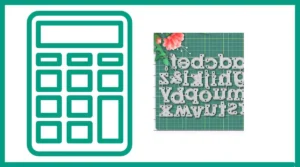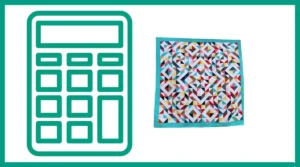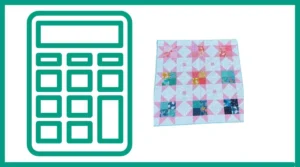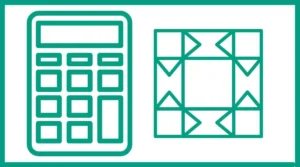What Are Flying Geese Blocks?
Flying geese blocks are triangular quilt units typically consisting of a large triangle (the “goose”) surrounded by two smaller triangles (the “sky”). When arranged in a row, these blocks create a sense of movement reminiscent of birds flying in formation. The standard finished size of a flying geese unit is twice as wide as it is tall, though variations exist.
The Importance of Flying Geese in Quilt Design
Flying geese blocks are incredibly versatile and can be used in numerous ways:
- Border elements
- Star points in complex blocks
- Standalone patterns
- Directional design features
Their triangular shape allows for creative arrangements, making them a staple in both traditional and modern quilt designs.
Basic Flying Geese Construction
There are several methods to construct flying geese blocks. We’ll cover two popular techniques: the traditional method and the four-at-a-time method.
Traditional Method: One at a Time
This method involves sewing two smaller triangles to a larger triangle.
- Cut one rectangle for the “goose” and two squares for the “sky.”
- Draw a diagonal line on the wrong side of each small square.
- Place a small square on one end of the rectangle, right sides together.
- Sew along the diagonal line.
- Trim ¼” from the seam and press the small triangle open.
- Repeat on the other end of the rectangle.
While this method is straightforward, it can be time-consuming when making many units.
Four-at-a-Time Method
This efficient technique produces four identical flying geese units with minimal waste.
- Cut one large square for the “geese” and four smaller squares for the “sky.”
- Mark diagonal lines on all four small squares.
- Place two small squares on opposite corners of the large square, right sides together.
- Sew ¼” on each side of the marked lines.
- Cut apart on the marked lines.
- Press the small triangles open.
- Repeat the process with the remaining two small squares on the other corners.
This method is particularly useful when making a lot of flying geese for a quilt project.
Using the Flying Geese Calculator
Our flying geese calculator is an invaluable tool for quilters. It helps determine the correct cutting sizes for your desired finished block size, eliminating guesswork and reducing fabric waste.
How to Use the Flying Geese Calculator
- Enter the desired finished width of your flying geese unit.
- The calculator will provide:
- Finished height (half the width)
- Size of the large square to cut (for the four-at-a-time method)
- Size of the small squares to cut (for the four-at-a-time method)
For example, if you want a finished flying geese unit of 3″ x 6″:
- Enter 6″ as the finished width
- The calculator will show:
- Finished height: 3″
- Large square (cut 1): 7.5″
- Small squares (cut 4): 3.75″
This tool is especially helpful when working with non-standard sizes or when scaling patterns up or down.
Cutting Chart for Common Flying Geese Sizes
While the calculator is useful for custom sizes, here’s a quick reference cutting chart for common flying geese sizes:
| Finished Size | Large Square (Cut 1) | Small Squares (Cut 4) |
|---|---|---|
| 1″ x 2″ | 3.5″ | 1.75″ |
| 1.5″ x 3″ | 4.5″ | 2.25″ |
| 2″ x 4″ | 5.5″ | 2.75″ |
| 2.5″ x 5″ | 6.5″ | 3.25″ |
| 3″ x 6″ | 7.5″ | 3.75″ |
Tips for Perfect Flying Geese
- Accurate Cutting: Precision in cutting is crucial for well-formed flying geese.
- Consistent Seam Allowance: Maintain a precise ¼” seam allowance throughout.
- Pressing: Press seams towards the darker fabric to prevent show-through.
- Trimming: For perfectly sized units, consider making oversized flying geese and trimming them down.
- Fabric Choice: Pay attention to directional prints when cutting and piecing.
- Chain Piecing: When making multiple units, use chain piecing to save time.
Advanced Flying Geese Techniques
Remember, these measurements include a ¼” seam allowance on all sides.
Oversized Flying Geese
Making oversized flying geese and trimming them down can result in more accurate units. Add an extra ¼” to ½” to your cutting measurements, then trim the completed units to the exact size needed.
Paper Piecing Flying Geese
For precise points and complex designs, consider paper piecing your flying geese. This method involves sewing fabric pieces to a paper template, ensuring accuracy in even the smallest units.
Specialty Rulers
Several specialty rulers are available for cutting and trimming flying geese. These can streamline the process and improve accuracy, especially when working with multiple units.
Troubleshooting Common Flying Geese Issues
Problem: Distorted or Wonky Units
Solution: Check your cutting accuracy and seam allowance. Consider starching fabrics before cutting to reduce stretch.
Problem: Points Cut Off
Solution: Ensure your ¼” seam allowance is accurate. When joining units, pin carefully to maintain point alignment.
Problem: Inconsistent Sizes
Solution: Use the oversized method and trim units to the correct size. A flying geese ruler can be helpful for consistent trimming.
Creative Applications of Flying Geese in Quilt Design
- Traditional Layouts: Rows of flying geese create classic border designs.
- Modern Interpretations: Experiment with asymmetrical arrangements or oversized geese.
- Color Play: Use ombré effects or high-contrast fabrics for striking visual impact.
- Mixed with Other Blocks: Combine flying geese with other quilt blocks for complex designs.
- curved Flying Geese: For advanced quilters, try incorporating flying geese into curved piecing.
Example Projects Using Flying Geese
Example 1: Classic Flying Geese Border Quilt
Create a stunning border quilt using rows of flying geese in graduating colors. Start with a simple patchwork center and surround it with four borders of flying geese, each row a different color. This design showcases the movement and directional qualities of flying geese blocks.
Materials needed:
- 1 yard each of 5 coordinating fabrics
- 2 yards background fabric
- Flying geese calculator for precise measurements
Steps:
- Use the flying geese calculator to determine cutting sizes for 3″ x 6″ finished units.
- Cut fabric according to the calculator’s recommendations.
- Create flying geese using the four-at-a-time method for efficiency.
- Arrange geese in rows, alternating directions for each border.
- Assemble the quilt top, adding plain borders between flying geese rows if desired.
This project demonstrates how flying geese can create a dynamic frame around a simple center, making even basic patchwork look sophisticated.
Example 2: Modern Scattered Flying Geese Wall Hanging
Design a contemporary wall hanging featuring flying geese in various sizes scattered across a solid background.
Materials needed:
- 1/2 yard each of 3-4 print fabrics
- 1 1/2 yards solid background fabric
- Flying geese calculator for multiple size calculations
Steps:
- Use the calculator to determine cutting sizes for flying geese in 2″ x 4″, 3″ x 6″, and 4″ x 8″ finished sizes.
- Cut fabric according to the calculator’s recommendations for each size.
- Create flying geese using both traditional and four-at-a-time methods.
- Arrange geese on the background fabric in a pleasing, scattered design.
- Appliqué or piece the geese onto the background.





